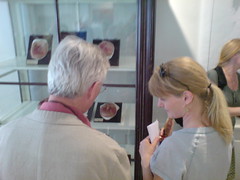Last Friday we held a reception at Medical Museion to celebrate the completion of the moulage conservation project. Nicole Rehné has meticulously restored our collection of 70 wax models made in the early 20th century for the Niels Finsen Medical Light Institute to demonstrate the symptoms of a various skin diseases, especially skin tuberculosis (Finsen was awarded the Nobel Prize in physiology or medicine in 1903).
Ion Meyer, who has supervised the project, spoke at the reception about the history of our moulage collection and Nicole spoke about the painstaking conservation work. Then our specially invited guest, Thomas Schnalke, director of the medical history museum in Berlin and renowned specialist of wax models of diseases (see Diseases in Wax: The history of the medical moulage, 1995) gave a talk with the title “What an Object Can Tell”, in which he made a nice analysis of what a skilled curator can get out from a case-study of a single wax model.
The material wax model collection invites to historical studies of the development of dermatological diagnosis from wax moulages to teledermatology. Wax moulages were frequently used in dermatological training around the turn of the last century. Now they are museum objects only — today’s dermatologists consult instead huge digital image collections like DermAtlas.
This in turn raises all sorts of questions about the interplay between imaging and communication technologies, collection systems and medical diagnosis. It also gives food for thought about museum collection and display practices, including the relation between the use of material artefacts and digital photo collections.
Here Nicole demonstrates some of the moulages to one of the reception guests:

(photo: Martha).
The project was made possible by a grant from the Kgl. Hofbuntmager Aage Bang Foundation.
